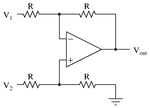nextivor
Newbie level 2
Hi, guys!
I am planning use the INA210 to do some design. INA210 is a difference amplifier shown in the pic1. It has two inputs IN+ and IN-, one output VOUT and one reference input Vref. And I asked the supporting team: what is the output of the amplifier when Vref is connected to GND. They replied me: since the amplifier can swing to GND with a offset (GND+0.005). So the output will always be Vin*Gain+0.005. I am very curious about this kind of "clamping" function. It stop the amplifier from saturation. How they design the output stage? (INA210 can have a wide input common mode voltage rang:-0.3-26V. If the common mode voltage is zero, Vref is also zero. Load resistor is connected to GND. These is no current flowing in the resistor at this moment, how can this amplifier can still have GND+0.005V output when input differential signal is zero ?)


I am planning use the INA210 to do some design. INA210 is a difference amplifier shown in the pic1. It has two inputs IN+ and IN-, one output VOUT and one reference input Vref. And I asked the supporting team: what is the output of the amplifier when Vref is connected to GND. They replied me: since the amplifier can swing to GND with a offset (GND+0.005). So the output will always be Vin*Gain+0.005. I am very curious about this kind of "clamping" function. It stop the amplifier from saturation. How they design the output stage? (INA210 can have a wide input common mode voltage rang:-0.3-26V. If the common mode voltage is zero, Vref is also zero. Load resistor is connected to GND. These is no current flowing in the resistor at this moment, how can this amplifier can still have GND+0.005V output when input differential signal is zero ?)
